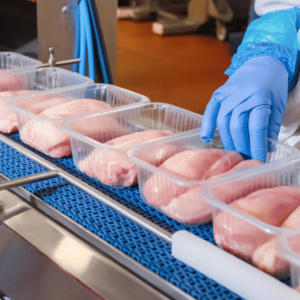MAP: Gas Hazards as a Result of Food Packaging & Transportation Innovations
Date of publication: 02.06.24
The demand for fresher and longer-lasting products in the food and beverage sector is constantly increasing. Food products are traveling further afield, reaching new customers in different destinations. This demand brings a need for better quality control methods, as well as the implementation of new technologies such as Modified Atmosphere Packaging (MAP).
There are a number of ways to slow down spoilage, keeping food attractive and edible for as long as possible. Refrigeration, for example, slows the growth of most microbes as a result of lowered temperatures. Pickling, alternatively, cures foods and thus prolongs life with additions of salt and/or artificial preservatives.
However, to keep food fresh for as long as possible without additives is a challenge, and one key technology for achieving this goal is to seal the food product in a package which contains a mixture of natural gases in carefully controlled proportions that significantly slow down the process of decay by inhibiting processes of oxidation and the growth of microbes. This is the essence of MAP: the atmosphere in which the food is packaged is modified so that spoilage is markedly reduced and the shelf life of the product is increased.
MAP works on the basis that gases in contact with the product are replaced by controlled gaseous mixtures, which in turn flushes air from the packaging. Although it differs from product to product, the most commonly used gases include carbon dioxide, oxygen, and nitrogen, these gases help to combat bacteria and stop oxidation of the food.
Common Gases Used in the Food Production Process
Carbon Dioxide and Nitrogen play significant roles in food preservation and transport. Nitrogen and Carbon Dioxide, either individually or in combination, serve to shield food from oxygen exposure at the initiation of oxidation. This protective action prevents the formation of undesirable compounds, unappealing flavors, and unpleasant odors in packaged food by displacing oxygen. Additionally, Nitrogen enhances freezing and refrigeration processes, while dry ice proves effective in deterring insect infestation in grains and agricultural products.
Oxygen is generally used to package meat products as it helps maintain coloring. As soon as the meat is cut, oxygen reacts with the myoglobin and creates the bright red color associated with oxymyoglobin. Nitrites keep meat red by bonding to the myoglobin and acting as a substitute for oxygen. Oxygen and sodium nitrate both turn myoglobin red, but nitrate attaches with a more stable bond and so the color lasts longer.
With so many gases being used within the food manufacturing process, the need for reliable gas monitoring equipment is essential. Analox provides monitors to cover every step of the “Farm to Fork” journey.
Food Packaging Solutions: MAP
Food packaging and storage techniques exploit the properties of atmospheric gases in order to create the optimum conditions for protecting food. Within the cheese packaging industry, for example, carbon dioxide (CO2) is the main gas used for hard cheese, whereas soft cheeses use a mixture of CO2 (20-40%) and nitrogen (N2). This is because hard cheeses that do not have a high water content are susceptible to attack by molds, while moisture cheeses can be affected by bacteria. Additionally, the fats of some cheeses are prone to oxidation by oxygen in the air, which can make the cheese become rancid.
Dangers Associated with Food Transportation
Much of the food we see in our grocery stores and supermarkets arrived there via transportation companies (home delivery and food transportation) by using dry ice to package the foods to keep them fresh or frozen—even if also utilizing MAP. As produce is traveling further and further around the world to reach its final destination, the freshness and longevity must be upheld, dry ice is a great way to ensure this. However, dry ice can be a very serious hazard in small spaces (e.g. confined spaces) that aren’t properly ventilated.
As dry ice melts, it turns into carbon dioxide gas. In a confined space, this gas can build up. If enough carbon dioxide gas is present, a person can become unconscious, and in some cases, die. Learn more about dry ice in our related gas blog, “An Education in Dry Ice”.
Analox’s CO2 Buddy is a self-contained portable carbon dioxide monitor that transportation workers use to protect themselves. One of the most compact units on the market, the CO2 Buddy can be clipped to a belt or clothing. The audible and visual alarms quickly alert users to the presence of CO2 and allow them to act before it is too late.
Analox also offers the Aspida portable monitor that not only protects users from CO2, but offers the added protection of monitoring inert gases like nitrogen that are frequently used in beverage and hospitality environments.
What Are Analox Doing to Help Curb the Dangers Associated with Food Production and Processing?
Production, transportation, and handling of food generate significant emissions such as Carbon Dioxide (CO2). When food ends up in landfills, it generates methane, an even more potent greenhouse gas. Throughout the food journey, there are significant risks to surrounding workers as a result of various processes.
Analox are committed to helping increase awareness of the dangers of CO2 in the Food and Beverage industry. As an industry-leading provider of CO2 sensors and gas alarms, we have the perfect solution available to help prevent more lives being endangered. The Ax60+ monitors both CO2 & O2 depletion caused by N2. We are advocating that companies who use gases for MAP should be protecting themselves and their staff against the dangers caused by CO2 and N2.
For more information on our gas analyzers and monitors, as well as details regarding how we can help improve the safety of workers on your site with a custom setup, please contact us directly.

